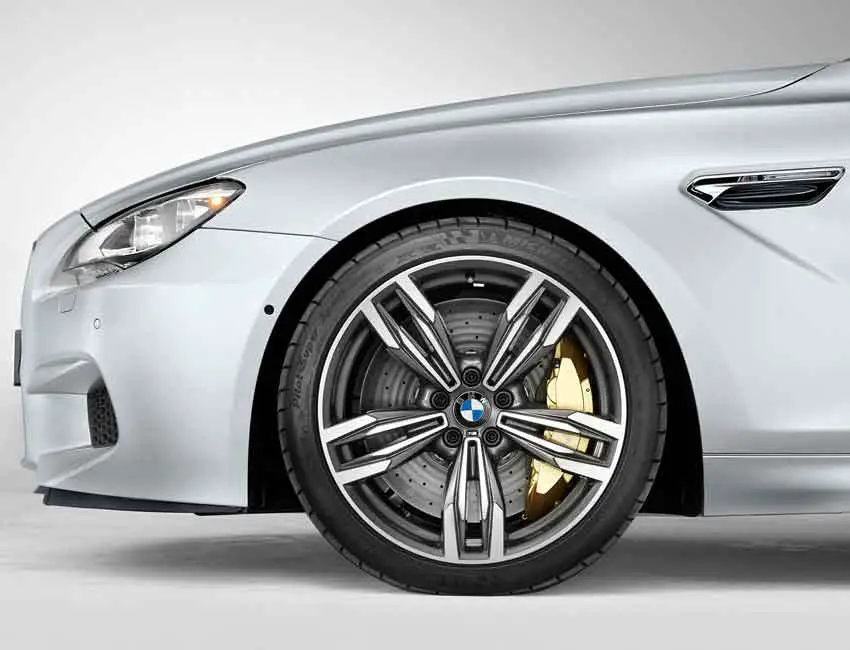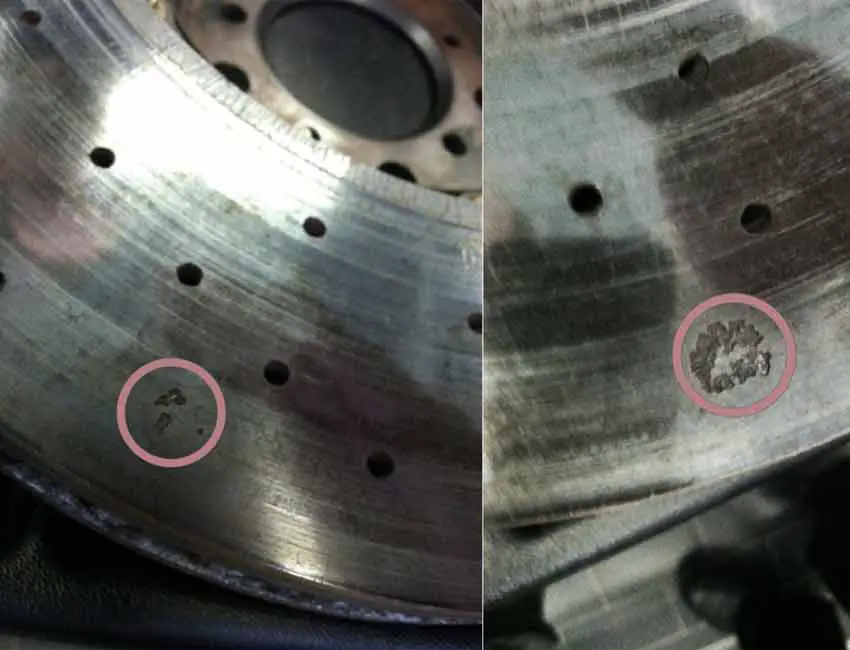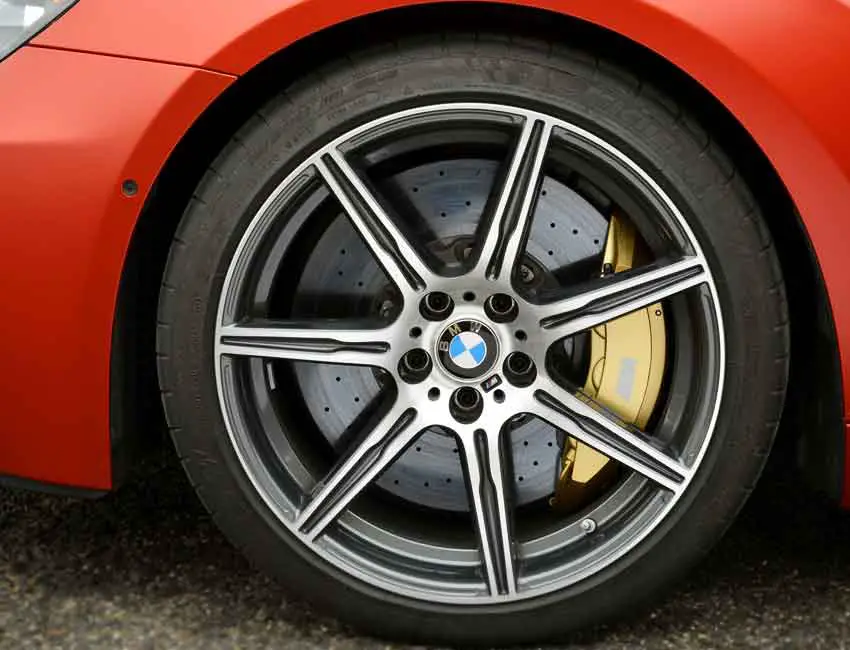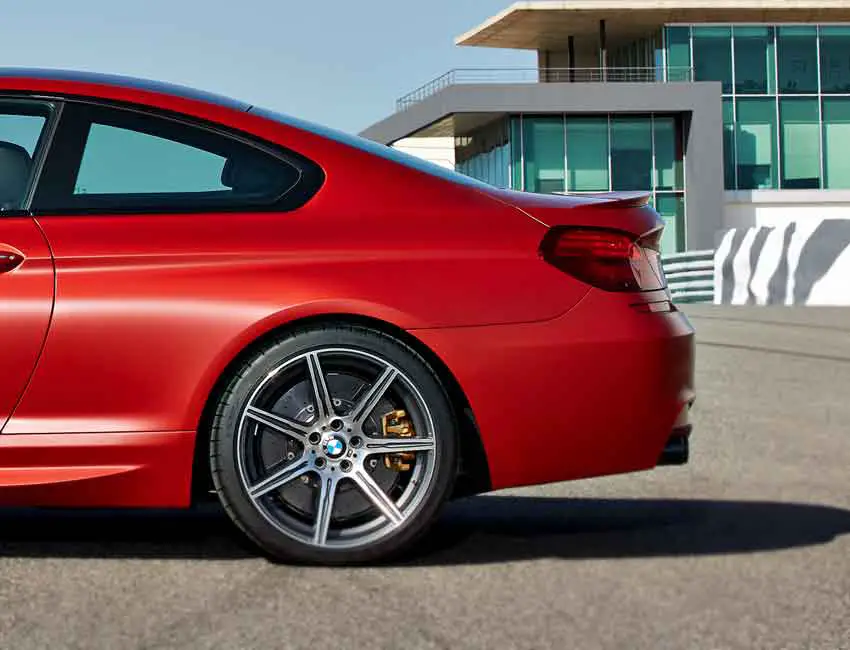Cost of the BMW M6 M Carbon Ceramic Brakes
As of March 2013, the M Carbon Ceramic Brakes became available on all new BMW M6 (2014 and later model years). Also known as the BMW C/SiC (Carbon Fiber Reinforced Silicon Carbide) Brakes, the M Carbon Ceramic Brake disc was fabricated from carbon fibers. The brake discs were manufactured by Brembo SGL Carbon Ceramic Brakes GmbH.
Cost of the BMW M6 M Carbon Ceramic Brakes
The M Carbon Ceramic Brakes can be added for an additional $9,250 as a Performance Option to the new BMW M6.
20-inch M wheels must be ordered (at no extra cost) in conjunction with the M Carbon Ceramic Brake option when purchasing a new M6. This is because the brake discs are larger on the front wheels and cannot fit into the stock wheels provided.
BMW M6 M Carbon Ceramic Brakes Versus M Compound Brakes

The BMW M6 M Carbon Ceramic Brakes are better in performance than the compound or the conventional brakes.
Comparing to the M Compound Brakes, the biggest advantage of the M Carbon Ceramic Brakes is their lightweight property. The M Carbon Ceramic Brakes also offer more stability because the operational surface of the brake pads is significantly higher.
The BMW M6 M Carbon Ceramic Brakes have the following Characteristics

- More direct and spontaneous use of brake force
- Higher fading stability
- 19.4 kg (about 42 lbs) weight reduction from the rotating wheel masses
- Increased reliability for winter driving conditions with corrosion resistance
- Painted in gold
Technical Data on the BMW M6 M Carbon Ceramic Brakes
| Designation | Unit | M Compound Brake System | M Carbon Ceramic Brake System |
|---|---|---|---|
| Front Brakes | 6 pistons, fixed caliper | 6 pistons, fixed caliper | |
| Diameter x Thickness, brake disk | [mm] | 400 x 36 | 410 x 38 |
| Friction path/Friction ring width | [mm] | 76.0 | 88.8 |
| Weight of brake disc | [kg/lbs] | 13.9 / 30.6 | 7.8 / 17.1 |
| Weight of brake caliper and pads | [kg/lbs] | 7.0 / 15.4 | 7.4 / 16.3 |
| Rear Brakes | 1 piston, floating caliper | 1 piston, floating caliper | |
| Diameter x Thickness, brake disk | [mm] | 396 x 24 | 396 x 26 |
| Friction path/Friction ring width | [mm] | 64 | 64 |
| Weight of brake disc | [kg/lbs] | 9.3 / 20.5 | 5.4 / 11.9 |
| Weight of brake caliper and pads | [kg/lbs] | 6.7 / 14.7 | 6.6 / 14.5 |
BMW M6 M Carbon Ceramic Brake Disc Design and Special Features
The BMW M Carbon Ceramic Brake disc body can have visible cracked patterns (relaxed microstructure). This is typical for the M Carbon Ceramic Brake disc, and the cracks can remain visible during normal drive. The brake disc is made up of two different materials:
- The support body with the cooling ducts has a sintered silicon carbide ceramic base that is reinforced with a high content of carbon fiber direction-oriented strands.
- The inner and outer friction coating has a much higher ceramic content.

BMW M6 M Carbon Ceramic Brake Disc Wear Characteristics
Comparing to the M Compound Brake Disc, the BMW M6 M Carbon Ceramic Brake disc has a much longer lifespan and can last the service life of the vehicle in ideal everyday driving. Over time, oxidation of the carbon fibers and sporting driving styles can cause the brake disc to lose weight and strength.
4 Wear Indicators of the BMW M6 M Carbon Ceramic Brake Disc

There are four indicators to check for signs of wear on the BMW M6 M Carbon Ceramic Brake disc:
- Check the disc surface for signs of wear and damage
- Three wear indicators are appearing as dark circular spots per friction surface located at every 120 degrees on the disc.
- When these indicators are subjected to high levels of oxidative wear, these wear indicator marks will become exposed
- Minimum brake disc weight should be 7954 g (about 17.5 lbs)
- Minimum brake disc thickness should be 37.85 mm (about 1.49 inches)
Braking Performance and Effect of the BMW M6 M Carbon Ceramic Brakes

- Cold brakes and tires: Depending on the braking situation, a spontaneous, hard brake effect can reduce the stopping distance slightly
- Warm brakes and tires: When the brakes and tires are in a warm state, performance of the braking effects will significantly improve
- Wet condition: Without a dry brake situation, a slight deceleration of braking force can be observed. Also, during low speed and cautious braking, an audible sound may occur with the wet M Carbon Ceramic Brakes
- Winter operation: During cold weather, the benefit of having M Carbon Ceramic Brakes versus the M Compound Brakes is its corrosion resistant advantage
Front Axle of the BMW M6 M Carbon Ceramic Brake Disc

The friction ring width (swept area) of the front M Carbon Ceramic Brake disc is 88.8 mm (about 3.5 inches). This is larger than the M Compound Brake disc, which measures 76 mm (about 3.0 inches).
The diameter of the M Carbon Ceramic Brake disc is 401 mm (about 16.14 inches), and its thickness is 38 mm (about 1.5 inches).
Front Axle Brake Disc Hub
The front axle brake disc hub is made of high strength aluminum alloy.
Front Axle Brake Caliper / Pad
The M Carbon Ceramic Brake caliper at the contact surface of the swivel bearing is 5 mm (about 0.19 inches) less than the M compound brake caliper. This is because the Carbon Ceramic Brake disc has a 5 mm larger radius and friction ring.
Overall, the weight of the front brake caliper including the brake pad is 0.4 kg (about 0.88 lbs) heavier than the M Compound Brake caliper.
Rear Axle of the BMW M6 M Carbon Ceramic Brake Disc

The rear M Carbon Ceramic Brake disc has the same diameter as the M Compound Brake disc. However, the thickness is 2 mm (about 0.78 inches) greater.
Rear Axle Brake Disc Hub
The rear axle brake disc hub is manufactured with high strength aluminum alloy, which is the same as the front axle brake disc hub.
Rear Axle Brake Caliper / Pad
The size of the rear axle M Carbon Ceramic caliper and brake pads are the same as the M Compound Brakes.
Information Engraved on the Front and Rear Axle Brake Disc Hubs

- Serial number
- Part number
- Direction of travel
- Minimum weight (wear weight)
- Minimum thickness (wear thickness)
- Week/year of manufacture

